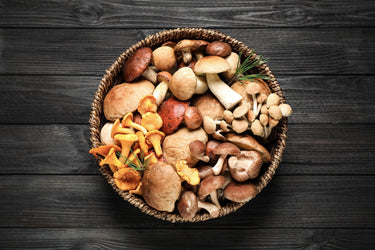How To Cook With Mushrooms

Mushrooms are a fascinating and diverse culinary staple. From their unique earthy flavors to their versatile culinary applications, mushrooms add depth and richness to a wide range of dishes. Portobello burgers can stand their own against the beef variety while oyster mushrooms add sophistication to a stir fry. Not just tasty, mushrooms offer an array of health benefits. They are rich in essential nutrients like B-vitamins, potassium, and selenium, and boast a collection of antioxidants that help fight oxidative stress in the body. Some varieties of mushrooms, like shiitake and maitake mushrooms, contain high levels of beta-glucan, which boosts the immune system.
5 mushroom varieties worth trying, plus how to cook them
Button mushrooms
Are you ready for your mind to be blown? White button mushrooms—arguably the most common mushroom at grocery stores in the United States—are the same as cremini mushrooms and portobello mushrooms. Button mushrooms are the immature form of the Agaricus bisporus edible fungus. They have a mild flavor and a meaty texture, great for eating raw (thinly slice them and dress like you would salad greens) or cooked (sauté, stir-fry, grill, braise, or roast). Because button mushrooms are relatively high in water content, they can be rinsed without fear of making them soggy.
How to sauté button mushrooms: Heat a pan over medium-high heat and add oil or butter. Once heated through, add the mushrooms and cook, stirring occasionally, until golden brown. This will take 5 to 10 minutes depending on the size of the pieces. Season with salt and pepper.
Cremini Mushrooms
Cremini mushrooms are a more mature version of Agaricus bisporus, which makes them the big sister of button mushrooms. You’ll also see these called baby bella mushrooms. Their more robust flavor makes them ideal for adding to sauces, soups, and stir-fries, where they can stand up to other ingredients. Sauté cremini mushrooms for adding to risotto or as a tasty omelet filling. Though cremini are more intense than button mushrooms, they still have a gently earthy taste.
How to sauté cremini mushrooms: Heat a pan over medium-high heat and add oil or butter. Once heated through, add the mushrooms and cook, stirring occasionally, until golden brown. This will take 5 to 10 minutes depending on the size of the pieces. Season with salt and pepper.
Portobello Mushrooms
The most mature version of Agaricus bisporus, portobello mushrooms have a meaty texture that makes them perfect substitutes for beef burgers. They benefit from a thorough cleaning before cooking to remove any dirt that clings to their gills. Portobello mushrooms do well with high heat preparations, which means they’re great on the grill, under the broiler, or in stir fries.
How to grill portobello mushrooms: Brush the mushrooms on both sides with a neutral oil. Grill over high heat until tender and slightly charred. This will take 6 to 10 minutes depending on the size of the mushrooms. Season with salt and pepper.
Shiitake Mushrooms
Shiitake mushrooms (Lentinula edodes) are prized for their rich umami flavor and intense meaty flavor. Ideal in stir fries and stews, shiitakes are worth the splurge. Their umbrella-shaped stems are ideal for sautéeing, stir frying, or roasting, while the tough stems are best saved to make stock. Cultivated on rotting wood logs, these mushrooms are native to East Asia and are now the third most cultivated mushroom worldwide. Because they maintain their texture even when cooked for a long time, shiitakes are delicious simmered in a stew or used in place of ground beef in a mushroom bolognese.
How to sauté shiitake mushrooms: Heat a pan over medium-high heat and add oil or butter. Once heated through, add the mushrooms and cook, stirring occasionally, until golden brown. This will take 5 to 10 minutes depending on the size of the pieces. Season with salt and pepper.
Oyster Mushrooms
Oyster mushrooms (Pleurotus ostreatus) are flat, fan-shaped mushrooms and have a mild, nutty flavor. No wonder oyster mushrooms are the second most cultivated variety worldwide. Beloved for their thin, delicate texture, oyster mushrooms develop a delectable crispy texture when fried, sautéed, or roasted. Cultivated oyster mushrooms tend not to need much cleaning, so brush off any dirt with a damp, clean towel rather than rinse them with water, which can cause them to become soggy. Rather than chop oyster mushrooms, it’s best to tear them into strips. To get the ideal, caramelized texture, oyster mushrooms do best without much stirring.
How to sauté oyster mushrooms: Heat a pan over medium-high heat and add oil or butter. Once heated through, add the mushrooms and cook, turning once, until golden brown. This will take 3 to 5 minutes per side depending on the size of the pieces. Season with salt and pepper.




